Samsung UE75ES9000 Review
Samsung UE75ES9000
It’s big, it’s beautiful, it’s expensive. Say hello to Samsung’s new flagship marvel.
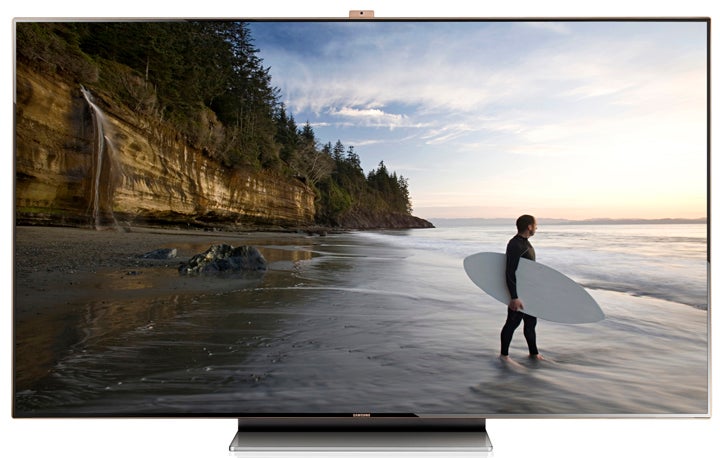
Verdict
Pros
- Outstanding all-round picture quality
- Gorgeous design
- Excellent multimedia features
Cons
- It's expensive
- Picture presets aren't helpful
- Shadow detail can sometimes get crushed
Key Specifications
- Review Price: £7500.00
- 75in LCD TV with edge LED lighting
- active 3D support
- local dimming
- Smart TV functionality
- Voice, gesture and motion controls
Introduction
The simple, headline fact about the Samsung UE75ES9000 is that it’s the biggest LCD TV Samsung has ever sold. But that’s not the only significant thing about it. For as the ES9000 part of its name shows, it’s also the first new flagship 9000 series TV Samsung has sold in the UK since its ‘pencil thin’ Samsung UE55C9000 model in 2010. This tells us two things: a) that it’s going to enjoy a truly premium design, and b) that it’s going to carry a substantial price tag.
Samsung UE75ES9000 Design
The Samsung UE75ES9000 design really is pretty extraordinary. For starters there’s the simple fact that you’re staring at a 75-inch screen. There’s no understating just how massive this looks in a normal living environment; even in our test room it cut one heck of a dash, blotting out nearly all of the projection screen we’d got hanging behind it. In fact, it’s the biggest ‘mainstream’ TV we’ve tested, since the even larger Panasonic plasmas that have crossed our threshold have been pro-grade monitors rather than tuner-carrying TVs.
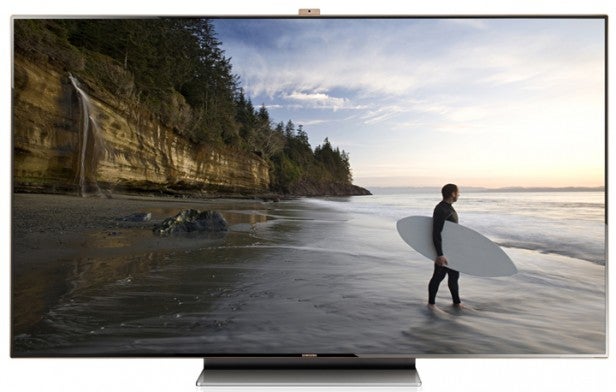
Then there’s the fact that this monstrous (in a good way) screen is surrounded by practically no bezel at all. There’s barely 1cm of it, which just doesn’t seem enough to support so much screen. What little bezel there is looks very cute too, with its black inner section and gold – sorry, Rose Gold Blush – outer wrapping.
The clue to how so little bezel can support so much screen becomes clear when you check out the rear of the Samsung UE75ES9000. For its rear panel is made of extremely sturdy polished metal, and the whole TV comes pre-mounted on a very robust-looking desktop stand.
While clearly better built than most, though, the Samsung UE75ES9000’s rear is also still fashionably slim. Not quite as physics-defyingly trim as that of 2010’s C9000 models, but at only a couple of centimetres or so deep it’s still strikingly slender for something supporting a 75-inch screen.
Samsung UE75ES9000 Specs
Closer inspection of the Samsung UE75ES9000’s rear reveals a camera behind the top edge. This is there to support the gesture and voice control (plus Skype) features already seen on the Samsung UE46ES7000 and Samsung UE46ES8000 TVs this year. But it’s interesting to see that you have to manually pop the camera up on the ES9000 model, rather than it being permanently present as happens with the ES7000 and ES9000. Perhaps Samsung is responding to concerns raised by some about having a camera permanently pointed into their living room.
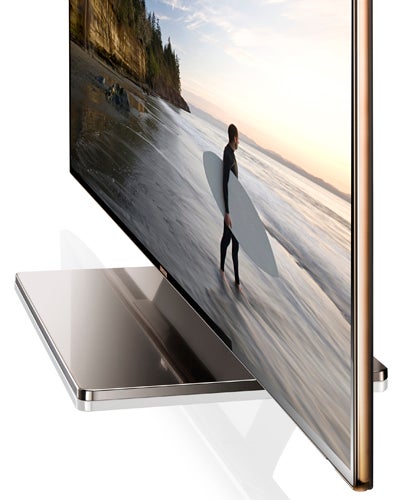
And so we get to the price. OK, deep breath: it’s £7,500. That’s £100 for every inch of picture by our math. But before anyone gets huffy about this price, while the Samsung UE75ES9000 will certainly never be mainstream, it’s worth pointing out that as well as being put together with high-end designer residences clearly in mind, it’s also the only 75-inch TV currently available in the UK. So it’s unique.
There are larger screens available from Sharp, LG, Sony and Panasonic, but aside from the astoundingly affordable 80-inch Sharp (£4750), you’re looking at prices of £25k for the 84-inch Sony KD-84X9005, a likely £15,000 minimum for the 84-inch LG 84LM9600, and a pension-draining £33,000 for the 85-inch Panasonic 85VX200W.
Admittedly the Sony and LG TVs mentioned there also offer 4K native resolutions while the Samsung UE75ES9000 is a standard full HD arrangement. But we feel there’s enough of a price ‘gap’ in the market right now for a premium – in design and specification terms – ultra-large HD set like the Samsung UE75ES9000 to slot into.
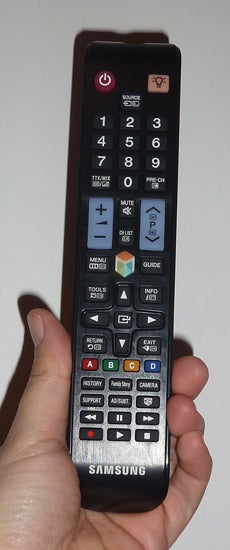
As you would expect of Samsung’s flagship TV this year, it’s mostly on the money with its multimedia features. Its connections include three USBs capable of playing back the vast majority of photo, music and video file formats, as well as built-in LAN and Wi-Fi options for people wanting to either stream material from DLNA PCs or Samsung’s Smart TV online service.
We’ve covered Samsung’s current Smart TV service at length already in other reviews, so we’ll restrict ourselves here to just pointing out that it’s the most content rich and best presented online service currently available on any TV. Especially since Samsung added lots more video streaming services as reported in our recent review of the Samsung UE46ES5500.
The only catch, really, is that there’s still rather a lot of ‘clutter’ in the shape of niche, pointless or just plain weird smaller apps that Samsung would be advised to trim down at some point.
Samsung UE75ES9000 Smart TV Features
In our recent review of the Samsung UE40ES7000, meanwhile, we also took a retrospective look at the gesture and voice controls that Samsung has been so proud of this year. And decided that for the most part we were happy to live without them. Actually, since with the Samsung UE75ES9000 you have to walk over to the TV and manually pop the camera up when you want to use it (unless you’re happy to leave it up all the time), we can imagine many households not using the voice and gesture control features at all.
We should add here, though, that the camera does offer face recognition, so that the TV can automatically tell who’s using it and open up their own personal accounts for such features as the online ‘Fitness Zone’ and Family Zone network. This is slightly useful (in that it saves you a few seconds of manual selection time), though it’s hardly an indispensable tool.
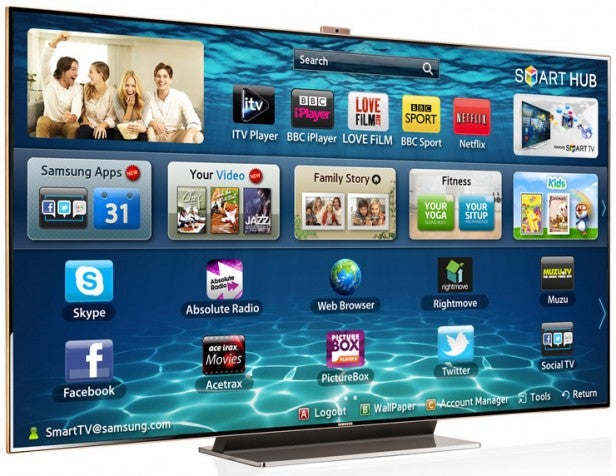
The key point about all this sort of stuff, it seems to us, is that we just don’t really see TVs being used in such an active way. TVs have always been passive forms of entertainment, and with so many phone/tablet/computer options now available to satisfy people’s ‘active’ needs, we don’t see a normal household’s relationship with their TV changing that much. Which is why we generally only get excited by video streaming services where online TV services are concerned.
One last ‘Smart’ feature of the Samsung UE75ES9000 worth mentioning is its support of Samsung’s Smart Evolution system, whereby you can update your TV with new processing power and features via slot-in Smart Evolution Kits. These upgrade modules are supposed to go on sale in 2013.
Samsung UE75ES9000 Picture Quality
A screen as big and expensive as the Samsung UE75ES9000 clearly needs to have some pretty uncompromising picture technology inside it. So it’s good to find the Samsung UE75ES9000 sporting both the top level of Samsung’s Micro Dimming Ultimate system (which breaks the picture down into small segments for more accurate analysis), and Samsung’s 800CMR processing, which combines a scanning backlight, native 200Hz panel and frame interpolation processing to deliver an 800Hz-like effect.
D glasses held in hand for Samsung TV” title=”Samsung UE75ES9000″ width=”300″ height=”193″ class=”align size-medium wp-image-237833″>
The most exciting development of all, though, is the introduction of local dimming. Dubbed Smart LED by Samsung, this system allows the TV to control sections of the edge LED lighting individually, with clear potential benefits to contrast. Samsung has even cleverly included an option that enables the screen to apply extra dimming to just the black bars above and below 2.35:1 (and similarly wide) aspect-ratio sources.
The Samsung UE75ES9000 is also, of course, 3D capable, and ships with four pairs of Samsung’s latest RF-using, startlingly lightweight 3D glasses.
Keen to find out how effective the new local dimming system is, we immediately fired into the Samsung UE75ES9000 a selection of our favourite dark scenes, from the likes of Prometheus, Alien, and Harry Potter and the Deathly Hallows Part II. And in all cases we were seriously impressed with what we witnessed.
Or at least we were once we’d taken the usual measure with Samsung TVs of adjusting pictures away from the provided presets. For the most part this involves ramping down the backlight to its ‘8’ level or even lower for dark room viewing, or its 11-12 value for bright room viewing, and taking contrast down to between 75 and 81.
Once this was done, we were immediately struck by just how much deeper and more even the Samsung UE75ES9000’s black levels look compared with even a calibrated Samsung ES8000 TV. There’s practically no greyness to be seen over dark areas, leaving them looking believably, deliciously black, and nor can you see much evidence at all of the clouds of inconsistent lighting you have to work so hard to avoid on Samsung’s lesser TVs.
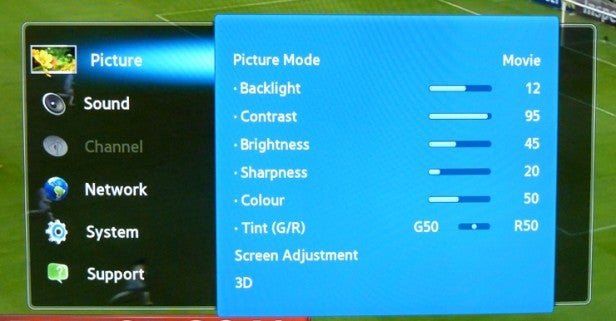
Even when watching 21:9 sources the brilliant feature that dims the parts of the picture corresponding to the black bars above and below the picture ensures that you don’t feel in the slightest bit distracted by any of the greyness or light ‘shifting’ generally evident in such areas with edge LED TVs.
Another excellent piece of news is that Samsung’s local dimming engine is clever enough to avoid the overt light ‘blocking’ artefacts so distracting this year on the locally dimmed edge LED TVs from LG and Panasonic. In other words, even when bright objects appear against dark backgrounds you don’t tend to see strips of light stretching out from around them across the picture.
This is a particularly impressive achievement by Samsung when you consider how far it’s having to push its edge-mounted lighting on this 75-inch screen. Our only word of caution here is that you avoid the High setting for the Smart LED system, as this can cause a few flickering and other artefacts with extreme-contrast material.
Samsung UE75ES9000 Picture Quality
Another great result of the local dimming system can be seen in the image’s stability during dark scenes. There’s far less evidence of the sort of brightness jumps and shifts that you tend to see with dynamic contrast systems that have to adjust all of their edge LED lights in tandem when trying to respond to changing source content.
In short, Samsung’s local dimming system is nearly as sophisticated and effective as that used by Sony this year on its ground-breaking Sony KDL-40HX853 model. The only major area where Sony’s system betters Samsung’s is when it comes to shadow detail reproduction, as the post-calibration Samsung UE75ES9000 crushes out more information in dark scenes than the Sony models do. This occasionally leaves dark scenes on the Samsung looking a touch hollow in places. But we found this surprisingly easy to live with given the extra dynamism the Samsung UE75ES9000 delivers.
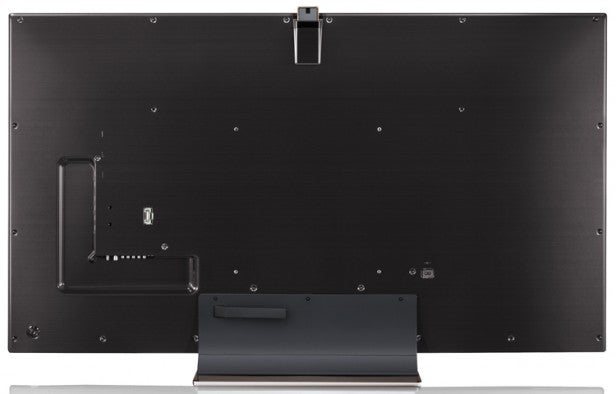
The improved black levels of the Samsung UE75ES9000 also help it produce better colours than Samsung’s already impressive ES7000 and ES8000 models. This is particularly the case in dark scenes, where the better black colours reduce almost to nothing the slight infusion of blue that can affect the ES7000 and ES8000s. Elsewhere, colours combine exceptional dynamism and range with just the sort of tonal subtleties that we hope to see on very high-end TVs.
Also startling is how sharp the Samsung UE75ES9000’s pictures are. All those lovely pixels that go into making a good HD picture are so much easier to appreciate on a screen of this magnitude, especially when that screen also suffers impressively little with LCD’s common motion resolution loss problems – especially if you use the provided motion processing (though we’d recommend only doing this on its relatively mild ‘Clear’ setting).
One thing we really didn’t expect to enjoy on the Samsung UE75ES9000 was standard definition. But actually, it doesn’t look bad at all. Samsung has put a lot of effort into its upscaling processing in recent years, and the results have never been more evident than they are in the way the UE75ES9000’s standard def sources look sharp without being noisy, and punchy while suffering hardly any of the colour accuracy reduction we often see with cheaper LCD TVs in standard def mode.
Having said all that, there were occasions during our tests when we questioned whether 75-inches is a bit of a stretch even for HD sources. We occasionally saw a touch of jaggedness around some bright edges, for instance, while if an HD source is particularly grainy – such as the Harry Potter Blu-ray – then the grain can start to look rather aggressive. So much so that we even tried doing something we never usually would: using the set’s noise reduction systems to calm the ‘fizzing’ down. This did work, but unfortunately it also caused a bit of image lag during shots containing a lot of motion – especially camera pans.
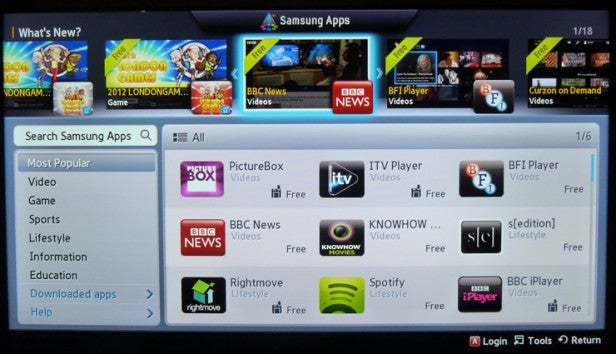
Of course, this issue isn’t the Samsung UE75ES9000’s fault. But the issue of just how far even HD can stretch on a TV has certainly been given added momentum by recent time spent with Sony’s 4K-resolution 84X9005.
Samsung UE75ES9000 3D Performance
Shifting our gaze to 3D, the Samsung UE75ES9000 continues to impress. For it manages to combine the positive 3D traits already identified in ES7000 and ES8000 reviews – relatively minor crosstalk, impressive brightness, excellent levels of sharpness/detail, and vibrant colour reproduction – with the sort of immersive impact you can only really get from a huge screen. There’s a little judder in motion at times, especially vertical motion, but overall 3D on the Samsung UE75ES9000 is about as much fun as it’s ever going to get.
And before anyone starts saying ‘ah, but passive 3D would have got rid of the crosstalk’, passive 3D would also have shown up some pretty severe visible line structure and jagged-edge problems on a screen of this magnitude. Unless it was using a 4k native screen resolution, as with the LG 84LM9600 or Sony KDL-84X9005.
Before tuning our ears into the Samsung UE75ES9000’s audio, we must just stress what an outstanding gaming monitor Samsung’s big boy is. As well as its contrast, colour and motion strengths all serving the likes of Borderlands 2 and Halo 4 brilliantly well, we measured an input lag figure of just under 30ms using the set’s Game mode, which is low by TV standards and so shouldn’t hamper your gaming skills.
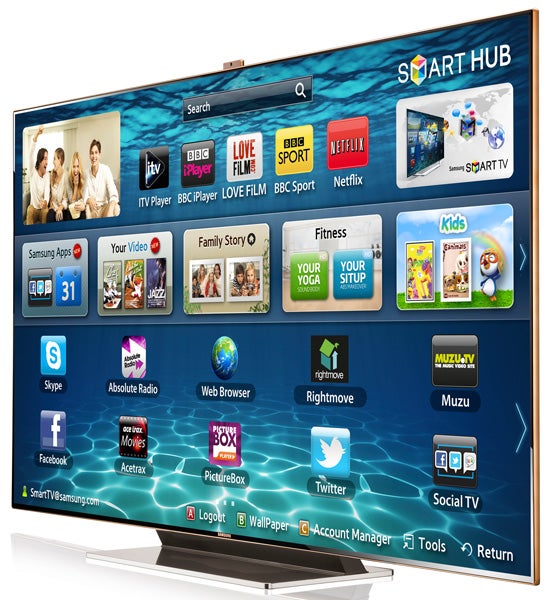
Experience suggests that a TV as obsessed with slender design as the Samsung UE75ES9000 will struggle to deliver a satisfying audio performance. But actually its sound performance is one of the finest we’ve heard from any TV, taking a startlingly open, powerful and rich mid-range as its starting point and adding in some good – but never stressy – treble detailing and even a convincing amount of bass. Outstanding.
Samsung UE75ES9000 Verdict
We were initially a bit suspicious about the Samsung UE75ES9000. In particular we had our doubts about how effective its locally dimmed edge LED engine would be, and whether it could really justify its £7,500 price.
But we’re pleased to say Samsung’s flagship set has thoroughly quashed our concerns, making a far more convincing case for its price than we’d ever expected by combining a peerless feature count with a show-boating design and arguably the most spectacular and immersive 3D and 2D pictures we’ve ever seen outside the megabucks native 4K world.
Now, if Samsung could just bring its local dimming tech to next year’s more affordable ES8000 and ES7000 models…
How we test televisions
We test every TV we review thoroughly over an extended period of time. We use industry standard tests to compare features properly. We’ll always tell you what we find. We never, ever, accept money to review a product.
Trusted Score
Score in detail
-
Features 10
-
3D Quality 9
-
Value 7
-
Design 10
-
2D Quality 9
-
Sound Quality 10
Features
| Size (Inch) | 75in |
| Display Type | LED |
| Max. Resolution | 1920 x 1080 |
| Full HD 1080p | Yes |
| Digital Tuner | Yes |
| Freeview HD | Yes |
| Freesat HD | Yes |
| 3D Ready | Yes |
| Refresh Rate (Hertz) | 800 (CMR)Hz |
Connectivity
| HDMI | 3 (v1.4) |
| Component | 1 |
| Composite | 1 |
| Scart | 1 (RGB) |
| Digital Audio Out | 1 (optical) |
| Headphone | 1 |
| Ethernet | Yes |
| WiFi | Yes (built-in) |
Physical Specifications
| Height (Millimeter) | 976.5mm |
| Width (Millimeter) | 1678mm |
| Depth (Millimeter) | 36.2mm |
| Weight (Gram) | 44g |

